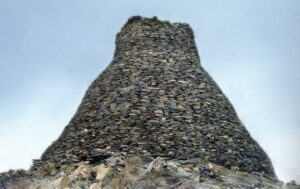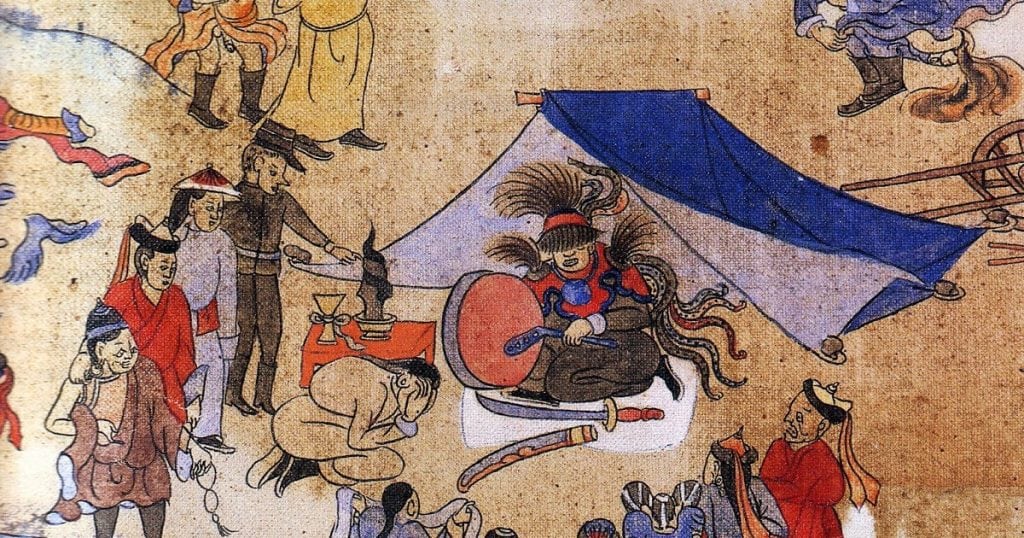Mongolian Shamanism is one of the oldest forms of religion. It has been developed on the basis of the belief in totemism and dates back to 300 to 400 BC. The Huns, ancestors of the Mongolians, worshiped shamanism and made it the state religion. Since then the people of Mongol origin, who lived in the territory of Mongolia, have been worshiped shamanism. The word shaman (böö) is a common noun that can be divided into two categories: a male shaman (büge) and a female shaman (idugan). Hun and Mongol people worshiped the sun and the moon and made sacrificial offerings to the heavens, the earth, spirits, and their ancestors.

The main rite of Mongolian shamanism is to worship and sacrifice heaven. Shamanism venerates the blue sky and green earth. In shamanism, there are 55 deities (Tenger) of the west who are well disposed towards humans and 44 deities (Tenger) of the east who cause all misfortunes. Mongolian Shamanism worships a total of 99 deities. These deities are answerable to the clans or tribes, including individual persons, before the power of nature. In addition, in Mongolian shamanism, there are water spirits (lus), and mountain spirits (savdag), as well as souls and amulets. Devotees worship these objects as their guardians.
The life of the hunters is devoted to catching beasts. There is a notion that the dispositions of wild beasts are linked to the spirits. This established a relationship between hunters and wild beasts and created a method for how to deal with them, together with rules on how to kill or control them. The rites involving libations and consecrations were established, as was a habit to preserve nature and conserve wild beasts. These habits became traditions that have been observed by nomadic peoples from generation to generation. Over time, the skills and methods used to domesticate some wild animals and to hunt others were transferred to animal breeders. The animal breeders then started worshipping nature, mountains, waters, and the sun and moon. These rituals formed and spread widely and have been performed and maintained up to the present day. In Mongolian shamanism, there is a view that every being has a spirit. The invocations, incantations, and consecrations in Mongolian shamanism are performed by Mongolian shamans, who are considered to be unusual and to possess the magical power or “ongon” of the spirits. There are three varieties of spirits. The first is the soul of a living being or of the body flesh obtained from the mother; the second is the conscience of thinking, which is the soul of bones obtained from the father; and the third is the soul, reincarnation, or spirit separated from the body after death. In Mongolian shamanism, the spirit is a life in the body. If the spirit is separated from the body, the living body dies. There are the notions of invocation of spirit and exorcism of the evil spirit. The shamans perform rituals of incantations, invocations, and exorcism.
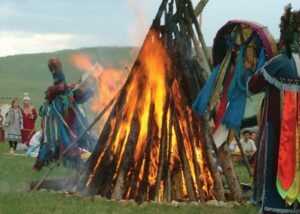
The aggregation of shamanistic views can be considered in the following sense:
- The preference for the penetration of the shamanistic spirit. The role of the shaman is to regulate and pacify them.
- The preference is to invite the shaman’s ongon, which serves to support good deeds and to drive away evil spirits. The ongon abides in holy places, so they are invited in to demonstrate their supernatural power.
- The preference for the magical ability of Mongolian shamanism in exorcising evil spirits. Devotees believe that the ongon of spirits can drive out misfortune, illness, and evil spirits with the guardian power of shamans. For instance, it is said in an invocation that exorcises evil spirits: We let you free,
When the horns of goats reach into space
When the scut of camels drags along the ground
When field hares grow horns
When calves shall have tusks
Rituals are the main elements of Mongolian shamanism and play very important role in its practices. There are two important entities that shamanic rituals seek to invoke or influence. The first is the White Heaven, which controls everything in the western direction. The other is the heart-shaped Black Heaven, which controls everything in the eastern direction. The shamanic rites seek to invoke the ninety-nine deities, to whom offerings are made. There are also the mountain-rites, cairn-rites, and tree-rites, and spring-rites, all of which are related to the traditions and rituals of worshipping the earth as Mother. Together with them, there are the fire–rites, ancestor-rites, saddle-thongs rites, destiny rides, and horse-rites. There are also the entrance-rites and lightning-rites. Shamanist rites assume that nature has godliness. Shamans use the rites to get into contact with this godliness, which occurs while the shamans are in a trance.
Fire Worshipping Ceremonies of Mongolian Tengrism
December 23rd and 24th of every lunar year are, for Mongolians, the days of worshiping fire. On December 23rd, the deity of fire appears and informs Indra about the living beings of the universe. The worshiping of fire of the Mongols has traversed many centuries, undergone various changes, and adapted to diverse local spaces, but its general tenor is the same.
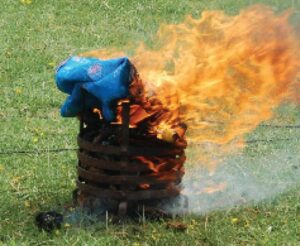
The masters of fire are called as “Mother of fire”, “Song of fire”, “Heaven of mother-fire” “Daughter-deity of fire,” and “Heaven of fire”. Since Buddhism spread over Mongolia, the name “Hermit heaven, King of the Fire Meraja” has become commonly used.
The preparation for worship is the first act of these rituals. Then the fire deity is invited. Offerings are made to them. Then the ode to fire is recited, and prayer and statement for fire deities and benediction are uttered. Then we entrust the fire deity to make the devotees healthy and wealthy and solicit offers in a melodious tune. The offerings of worship were shared with all the participants. The proceedings of the rituals of worshiping fire are established in detail. For example, the color of fire is red, so the breast of a sheep is covered by red threads. We regard the khyalgana as the best sort of grass for animals and put a piece of this grass on it. As we call upon horses to be scattered over the valley, we offer the breast. We also offer ribs as an offering of camels, rectum of sheep as an offering of sheep, and the area outside of the breast as an offering of goats. We kindle ghee lamps and incense on four sides of the trivet to prevent a fire from the evils. The offerings to the fire must be sanctimonious. So, wood for the fire-worship is collected from the places where animals do not trod. The breast meat, which is used for worship, is prepared in the autumn and kept in a store cleanly.
Mongolians celebrate the ritual of worshipping fire as the “small Lunar Month” and perform them according to the established rules. The statement, invocation, and benediction of worshipping fire were orally transmitted and, later, they written in sutras and books. Here, let us quote a short benediction of worshiping fire:
We pray by proffering grease
To the noble spirit of fire
Flaming as a cloud;
Feeding the ground with its warmth
May a good omen prevail the world over!
We drop melted grease on
Your flame and pray for you;
We may stay in boundless ecstasy
By having numberless animals
By sanctifying this holy spirit of worship;
Let our animals increase
Let our life be longer
Let us live in incomparable rapture;
We beseech the offerings
From magnanimous mother-fire
Whose origins are from heaven
Whose birth was from earth
Khurai, khurai, khurai!
We beseech an offering
From fire heaven
Whose origin is from Heaven
Whose birth is from the green earth.
Khurai, khurai, khurai!
We beseech a bounty
From the propitious mother-fire
Whose origin from powerful Heaven
Whose birth is from mother-earth
Khurai, khurai, khurai!
We beseech the bounty of
Longevity and animals
From the sacred fire Heaven
Starting from a golden planet
Khurai, khurai, khurai!
We beseech an offering
Of the group of camels ruled by the camel stallion
And of the herd of cows ruled by the bull
From the lambent fire
Khurai, khurai, khurai!
We beseech an offering of gold, silver and money
For the family and individuals
A harem of horses
From lambent mother-fire
Khurai, khurai, khurai!
We beseech a flock of sheep, a source of happiness
From the holy fire-heaven
Which is the origin of hearth and altar;
Dear fire-mother
Please give a piece from
Your body like a mountain;
Dear mother-fire
Split a piece
Of your body like rock and give it to us;
Dear light-mother
Break off a piece
Of your body like the Geser and give it to us;
Sanctified mother
Cut off a piece of
Your body like the ocean and give it to us;
The spirits of
The thick maned stallion
And of the mare with the caked udder
Khurai, khurai, khurai!
Taboos Concerning Fire Worship and The Family Hearth
Mongolians venerate the fire and hearth as holy and have many taboos originated from the rites and customs concerned with it. For instance:
-Non-members of a family or strangers are not entitled to
stoke a family’s fire. If he or she stokes a fire of another family,
it can be considered as an insult to a family’s hearth;
-It is forbidden to cross the northern part of a family’s hearth.
If this happens, it is a sign of disrespect or humiliation;
-It is forbidden for one to go around the hearth in a counterclockwise
direction;
-It is forbidden to stoke a fire with an iron poker within a week
of the ceremony of worshiping fire (this is considered to be a
period of the absence of the fire-god);
-Maternal nieces are forbidden to enter when the maternal
uncle’s ceremony of worshiping fire is performed;
-It is forbidden to give dairy products and grains to somebody
within three days of the ceremony of worshipping fire;
-Mothers who recently gave birth are forbidden to come near
the burning fire;
-It is forbidden to burn anything that can defile a fire or make
it dirty;
-It is forbidden to pour water on a fire (If we need to extinguish
a fire with water, we say, “Please take off your legs, dear god of
fire,” in advance and extinguish the fire);
-It is forbidden to spit into a fire;
-It is forbidden to play with fire (If one does this, it is considered
as the loss of animals);
-It is forbidden to trample a fire in extinguishing it;
-It is forbidden to sit down with parted legs near a hearth or
fire place;
It is forbidden for a pregnant mother to be present during the
ceremony of worshipping fire when milk-vodka and melted
grease are dropped onto a fire (It is believed that the pregnant
mother would be at risk of a miscarriage. So it is considered
as a danger.);
-It is forbidden to go cross over a fire;
-It is forbidden to drop milk on a fire (It is believed that the
udder of cow might break.);
-It is forbidden to wave a red cloth over a fire;
-It is forbidden to stab a fire with a knife;
-It is forbidden to burn dog faeces and the skins of onion and
garlic;
-It is forbidden to burn Artemisia.
There is a saying:
Do not sanctify your fire with artemisia.
Do not infect your corral of sheep with parasites.
-It is forbidden to drop salt on a fire (Only when we drive out
evils, do we burn salt);
-It is forbidden to point one’s finger at a fire (It is believed that
the god of fire might get angry.); and
-It is forbidden to stand or sit on the stove or trivet.
There are many forbidden practices concerning fire and the fire-worship ceremonies in ancient law. People were subjected to severe punishment if they assaulted someone’s hearth. We, Mongolians, venerate fire, sun and moon in our genius and wish our hearth and altar to be holy forever and as prosperous as the flames of fire.
Cairn-Worshipping Ceremonies
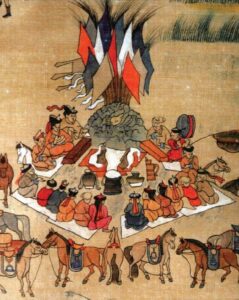
The rituals of mountain and cairn worship were originally shamanistic, but they were enriched and developed with the notions and teachings of Buddhism and concepts of nature and the universe. This ceremony involves inviting the spirits of the mountains and water to please and express our requests to them.
According to Mongolian shamanism there are spirits in the trees, mountains, and water. There are two spirits, savdag and lus. These are words borrowed from Tibetan. Savdag means master of the earth or mountain nymphs. Lus means master of water and humidity or water nymphs. In the sutra Buman tsagaan lus there is a definition: “The water spirit exists in water, the earth spirit exists in the ground. The wrathful deity lives in space.”
The water spirits are defined as blue, yellow, and black, according to their colours. The white king deity is the king of the all the masters of water. The good and bad omens of human beings depend upon the will of the white deity. We beseech the white deity to cause us to be in his good graces and make offerings of a boiled saddle of mutton, sacred cakes, rendered cream, ghee lamps, grain and milk vodka, and other things to him.
There are provisions for rituals at a cairn or sacred site. There are thirteen cairns in an array which are to be sanctified. The middle cairn is the biggest and tallest and is a symbol of Sümber agula (Lofty mountain). There are two cairns from the middle cairn on the western and eastern sides. They are symbols of the four great continents. They are smaller than the middle cairn. There are another small eight cairns. They are known as the eight little continents.
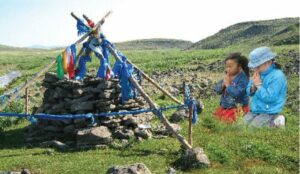
The day to observe the cairn-worshipping ceremony is selected by astrologist in advance. Then it is announced to the locality. Early in the morning before the sun rises, local people start moving to a place where the cairn worshipping ceremony is to be performed. People attend a cairn-worshipping ceremony preparing offerings in advance and wear their holiday clothes. We esteem this event greatly. A person, who receives the stomach of a sacrificed sheep in the previous cairn-ceremony can prepare an offering of meat for this ceremony.
On the appointed day monks gather. The bottom ends of four poles are driven into the ground in four directions and the upper ends of four poles are connected and festooned with decoration of various colours. The four square cloth tents are erected before the cairn. The first tent is dedicated to monks who are going to congregate. Other two tents are for use by dignitaries near and in front of the cairn . A white sheet of linen is unfolded on which the statues of Buddha and of other Buddha are placed. It is compulsory to place the statue of ThunderBolt (Vajrapani). Sacred cakes and other offerings for mountain and water nymphs are placed before the statutes of the Buddha.
These offerings consist of dairy products, boiled mutton, skim of milk and rendered cream. The cairn worshiping ceremony starts by offering a sacred cake to the ThunderBolt. The benediction prayer seeks to supplicate the ThunderBolt, which is the esoteric master. It is believed to be the destroyer of all the evils and saviour to assist in the burden of suffering beings. It also aids in getting rid of evils and driving out evils that live in the upper and lower realms with the bright flames. After this offering, sacred cakes are proffered to the ThunderBolt. The monks burn dry juniper needles and incense and other aromas. They chant sutras dedicated to the mountains and cairns. When they chant they enumerate the names of mountain and water spirits, and extol and invite them to patronize the local people. Attendants get an endowment of the offerings. After this, the leading monk of the cairn worshiping ceremony makes a libation of grains and milk vodka. At this time the monks chant sutras, such as the White Umbrella, which implies the illumination of the darkness in ten directions, the Eight Saints, the Aggregate of providence, the Eight Saints of space, the Tree sutra, the Provider for water spirits’ grace and other auspicious poems.
After it, Nanti, Ubanantu, and other spirits of water and supporters of holiness are invited to deliver bounties for the sake of all beings. At the end of the event, the monks, who were congregating, go out of the tent and each monk takes a pebble from the ground and put it on the stone cairn, places sacred cake at the middle of the stone cairn, four long ribs of the shoulder at the backside of the stone cairn, and fat tail at the east side and silver-coin at the south side and khadag (sacred scarf). At the north side of the cairn-stone, the monks consecrate the pebbsles which they took with milk vodka, and holy water and place them at the back of the stone cairn. Thus, the cairn worshiping ceremony is over.
After the ceremony is finished attendants come down to the foot of the mountain and attend a small Naadam event, including horse racing, wrestling and archery, with the accompaniment of singing and reciting of benedictions and odes. In such a manner the mountain and water spirits are pleased with Mongolia.
